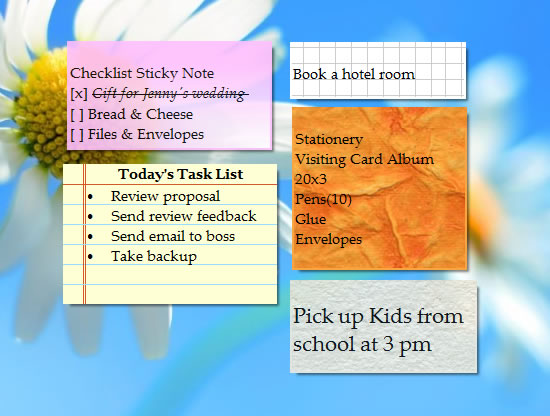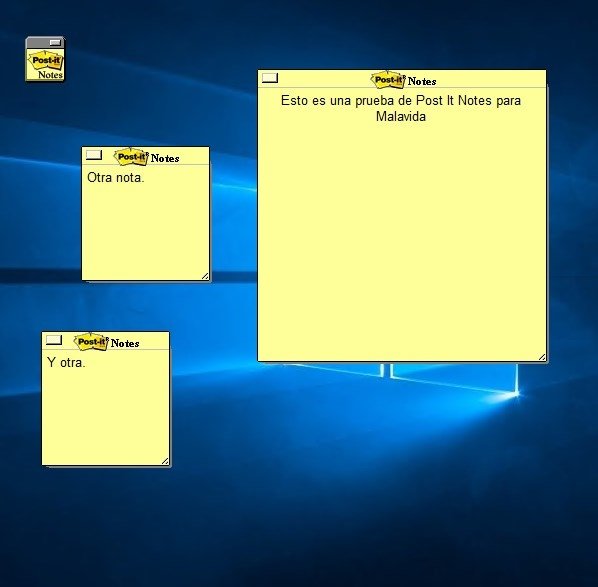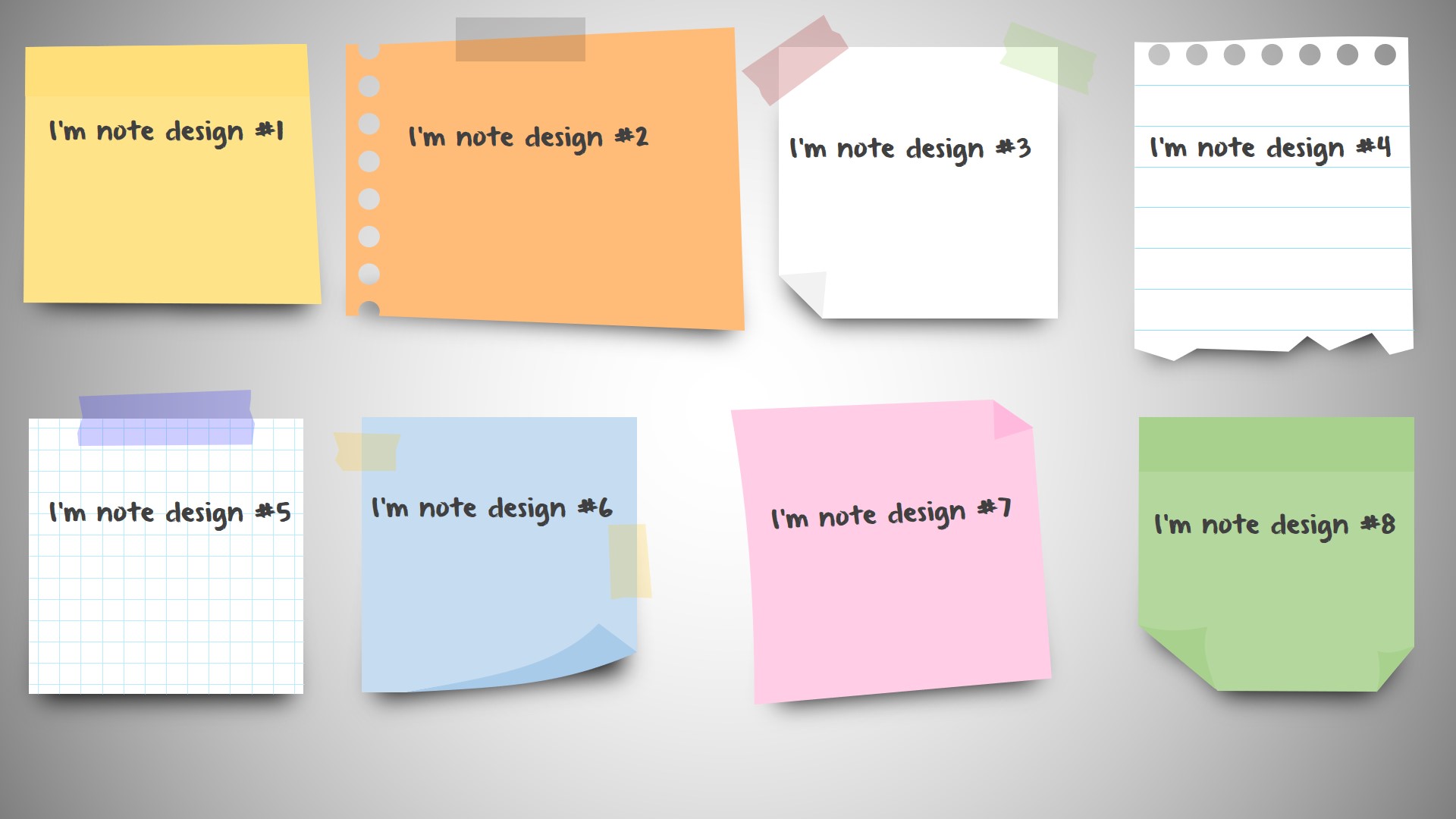- Use our sample 'Sample Blog Post.' Read it or download it for free. Free help from wikiHow.
- 3 x 'Left off on' Post-It notes 3 x 'You had a visitor' Post-It notes 3 x 'Visit JW.org' Post-It notes 1 x 'Field service report' Post-It notes Quality made on 80g paper; Adhesive 3' x 3' pads with 1000 sheets total Special offers and product promotions.
- OneNote (Post-It) Notes on Desktop Does OneNote have the option to let you put Post-It notes on your desktops, like Sticky Notes does? I cannot find how to do this in OneNote.
Water-Resistant Post-It Notes for Rough Surfaces. Stick messages anywhere, even in hot, cold, or wet conditions. The heavy duty paper is coated to repel water and retain writing. Extra-strong adhesive clings to any surface, including concrete, painted wood, and tile, but is too strong for paper. Color: Number of Sheets: Pkg.
A note to Tucows Downloads visitors:
All good things…
We have made the difficult decision to retire the Tucows Downloads site. We’re pleased to say that much of the software and other assets that made up the Tucows Downloads library have been transferred to our friends at the Internet Archive for posterity.
Computer Post It Notes Free
The shareware downloads bulletin board system (BBS) that would become Tucows Downloads was founded back in 1993 on a library computer in Flint, MI. What started as a place for people in the know to download software became the place to download software on the burgeoning Internet. Far more quickly than anyone could have imagined.
A lot has changed since those early years. Tucows has grown and evolved as a business. It’s been a long time since Tucows has been TUCOWS, which stood for The Ultimate Collection of Winsock Software.
Download Post It Notes
Today, Tucows is the second-largest domain name registrar in the world behind Go Daddy and the largest wholesaler of domain names in the world with customers like Shopify and other global website builder platforms. Hover offers domain names and email at retail to help people brand their life online. OpenSRS (and along the way our acquisitions of Enom, Ascio and EPAG) are the SaaS platforms upon which tens of thousands of customers have built their own domain registration businesses, registering tens of millions of domains on behalf of their customers. Ting Internet is building fiber-optic networks all over the U.S. At the same time, we’re building the Mobile Services Enabler SaaS platform that is powering DISH’s entry into the US mobile market.
Point is, we’re keeping busy.
For the past several years, history, well sentimentality, has been the only reason to keep Tucows Downloads around. We talked about shutting the site down before. Most seriously in 2016 when instead, we decided to go ad-free, keeping the site up as a public service.
Today is different. Tucows Downloads is old. Old sites are a maintenance challenge and therefore a risk. Maintaining the Tucows Downloads site pulls people away from the work that moves our businesses forward.
Tucows Downloads has had an incredible run. Retiring it is the right move but that doesn’t alter the fact that it will always hold a special place in hearts and our story. We’re thankful to the thousands of software developers who used Tucows Downloads to get their software in front of millions of people, driving billions of downloads over more than 25 years.
Thank you.
Sincerely,
Elliot Noss
CEO, Tucows
A note to Tucows Downloads Authors/Developers
If you’re a developer who used the Tucows Author Resource Center (ARC) as part of your software dissemination, to buy code signing or other services, we’re happy to help with the transition.
Any certificates purchased through ARC remain valid. If you’re looking to buy or renew code signing certificates, we invite you to go straight to the source; Sectigo was our supplier and will be happy to be yours too.
Feel free to reach out to us at help@tucows.com if we can help with anything at all.
Brown Note is a desktop notes application written in Python, using PyQt.
Notes are implemented as decoration-less windows, which can be dragged around the desktop and edited at will. Details in the notes, and their position on the desktop, is stored in a SQLite file database, via SQLAlchemy, with note details and positions being restored on each session.
Introduction to the data model
Data model
The storage of user notes in the app is handled by a SQLite file database via SQLAlchemy, using the declarative_base interface. Each note stores its identifier (id , primary key), the text content with a maximum length of 1000 chars, and the x and y positions on the screen.
The creation of database tables is handled automatically at startup, which also creates the database file `notes.db` if it does not exist. The created session is used for all subsequent database operations.
Creating new notes
Python automatically removes objects from memory when there are no further references to them. If we create new objects, but don't assignment to a variable outside of the scope (e.g. a function) they will be deleted automatically when leaving the scope. However, while the Python object will be cleared up, Qt/C++ expects things to hang around until explicitly deleted. This can lead to some weird side effects and should be avoided.
The solution is simple: just ensure you always have a Python reference to any PyQt object you're creating. In the case of our notes, we do this using a _ACTIVE_NOTES dictionary. We add new notes to this dictionary as they are created.
The MainWindow itself handles adding itself to this list, so we don't need to worry about it anywhere else. This means when we create a callback function to trigger creation of a new note, the slot to do this can be as simple as creating the window.
Starting up
When starting up we want to recreate all our existing notes on the desktop. We can do this by querying the database for all Note objects, and then creating a new MainWindow object for each one. If there aren't any we just create a blank note.
The Note widget

The notes are implemented as QMainWindow objects. The main in the object name might be a bit of a misnomer, since you can actually have as many of them as you like.
The design of the windows was defined first in Qt Designer, so we import this and call self.setupUi(self) to intialize. We also need to add a couple of window hint flags to the window to get the style & behaviour we're looking for — Qt.FramelessWindowHint removes the window decorations and Qt.WindowStaysOnTopHint keeps the notes on top.
To complete the setup for notes we need to either store the existing Note object (from the database) or create a new one. If we're starting with an existing note we load the settings into the current window, if we've created a new one we save it to the database.
This initial save just stores the position + an empty string. On a subsequent load we would have the default empty note.
We define a method to handle loading the content of a database Note object into the window, and a second to save the current settings back to the database.
Both methods store to `_ACTIVE_NOTES` even though this is redundant once the first storage has occurred. This is to ensure we have a reference to the object whether we're loading from the database or saving to it.
The last step to a working notes application is to handle mouse interactions with our note windows. The interaction requirements are very basic — click to activate and drag to reposition.
The interaction is managed via three event handlers mousePressEvent, mouseMoveEvent and mouseReleaseEvent.
The press event detects a mouse down on the note window and registers the initial position.
The move event is only active while the mouse button is pressed and reports each movement, updating the current position of the note window on the screen.


Finally release takes the end position of the dragged window and writes it to the database, by calling save().

The delete note handler shows a confirmation message, then handles the delete of the Note object from the database via db.session. Thefinal step is to close the window and delete the reference to it from_ACTIVE_NOTES. We do this by id, allowing us to delete the PyQt object reference after the Qt object has been deleted.

Theming Notes
Download Post Its
We want to add a bit of colour to our notes application and make them stand out on the desktop. While we could apply the colours to each element (e.g. using stylesheets) since we want to affect all windows there is a simpler way — setting the application palette.
Download Post It Note
First we create a new palette object with `QPalette()`, which will contain the current application palette defaults. Then we can override each colour in turn that we want to alter. The entries in a palette are identified by constants on `QPalette`, [see here for a full list]().
